Physical Address
304 North Cardinal St.
Dorchester Center, MA 02124
Guideline updates emphasize the efficacy of surgical approaches to myocardial revascularization in patients with multivessel coronary artery disease.
Perioperative risk reduction includes careful consideration of all of the patient's relevant antihypertensive, antiplatelet, and antianginal medications.
Significant valvular abnormalities in patients scheduled for coronary revascularization should be evaluated and considered in surgical planning.
Off-pump coronary artery bypass surgery is an established alternative to on-pump myocardial revascularization (ie, coronary artery bypass grafting [CABG]). The choice and outcomes of either approach are highly surgeon dependent. Despite apparent advantages of avoiding cardiopulmonary bypass (CPB), evidence from large prospective trials enrolling mostly low-risk patients has not shown clear reductions in mortality with an off-pump approach.
Possible indications for pulmonary artery catheter use in CABG surgery include patients with pulmonary hypertension, right-sided heart failure, or severely impaired ventricular function, particularly those who require postoperative cardiac output monitoring.
Fast-tracking, including early extubation and mobilization, has been almost universally adopted for patients undergoing myocardial revascularization.
Anesthetic drugs, especially inhaled anesthetic agents, may help to ameliorate myocardial injury associated with CPB and aortic cross-clamping by their preconditioning and postconditioning effects. However, the magnitude of these effects on outcome remains controversial.
The role of the cardiac anesthesiologist in the perioperative care of patients undergoing myocardial revascularization continues to evolve. Achievements of the past two decades include providing safe anesthesia that allows rapid recovery and optimizing monitoring that includes the establishment of transesophageal echocardiography (TEE) as a standard of care in the cardiac operating room. More recent developments in patient care include the introduction of a perioperative surgical home, which affects the management of patients undergoing myocardial revascularization. The anesthesiologist is vitally important in the multidisciplinary approach to patient care. Optimal perioperative care requires close collaboration and coordination between the various specialties involved on the heart team. The process begins with the decision to proceed to surgery and continues with preoperative optimization, state-of-the-art perioperative and postoperative care, and rehabilitation after hospital discharge. Beyond safe anesthesia technique, the anesthesiologist must be well versed in all areas of perioperative management for patients with coronary artery disease (CAD). This includes advances in pharmacologic risk reduction, new surgical techniques, and anesthetic management and monitoring techniques to improve patient outcomes.
According to the American Heart Association Heart Disease and Stroke Statistics, most recently updated in 2014, epidemiologic data relevant to cardiovascular disease can be summarized as follows. Overall rates of death attributable to cardiovascular disease have declined 31%; for CAD, there was a 39.2% decrease from 2000 to 2010. This was partially attributed to improvements in acute treatment of patients with acute coronary syndromes (ACSs), secondary preventive therapies after myocardial infarction (MI), treatment of acute heart failure (HF), revascularization of chronic CAD, and other preventive therapies. However, the prevalence remains high, with cardiovascular disease accounting for 31.9% of all deaths in the United States. Based on current estimates, by 2030 43.9% of the US population will have some form of cardiovascular disease. Similarly, 15.4 million individuals had CAD in 2010; and ischemic heart disease causes approximately one of every six deaths in the United States. In 2010, 379,559 Americans died of CAD, and statistically, every 34 seconds one person in the United States has a coronary event.
Between 2000 and 2010 the total number of inpatient cardiovascular procedures in the United States increased by 28%, with a total of 7,588,000 cardiovascular procedures performed in 2010. In 2010 an estimated 219,000 patients underwent 397,000 coronary artery bypass graft (CABG) procedures ( Fig. 14.1 ). The in-hospital mortality rate for CABG declined by 50% despite an increase in the comorbidity index. CAD alone resulted in more than $44 billion in expenses, making it the most expensive condition treated. The total direct and indirect cost of cardiovascular disease and stroke was estimated to be $315.4 billion in 2010, more than for any other diagnostic group.
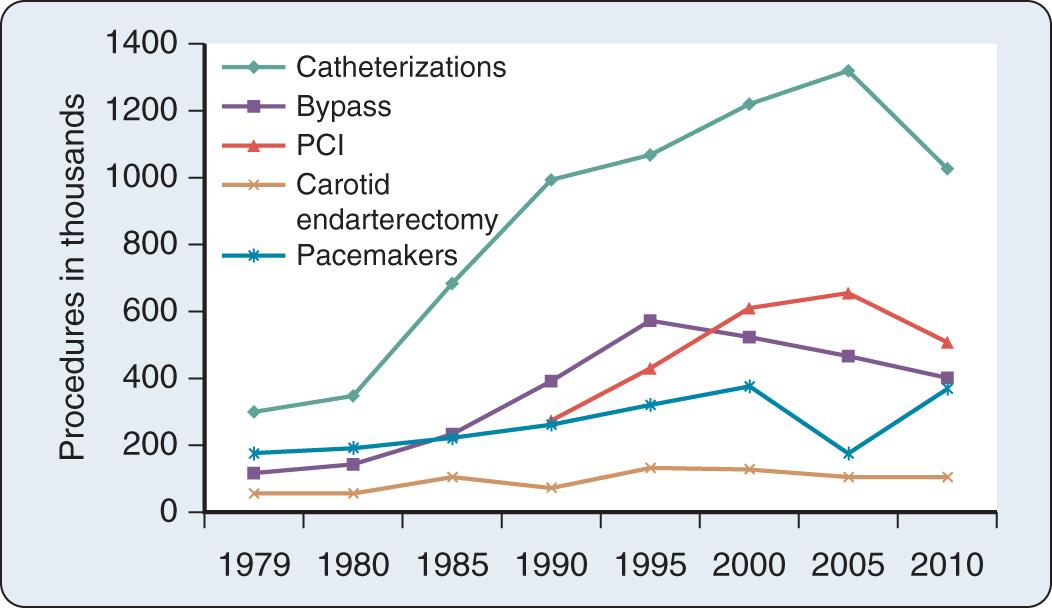
The anesthesiologist should be familiar with coronary anatomy if only to interpret the significance of angiographic findings. The coronary circulation and common sites for placement of distal anastomoses during CABG are shown in Figs. 14.2 through 14.4 .
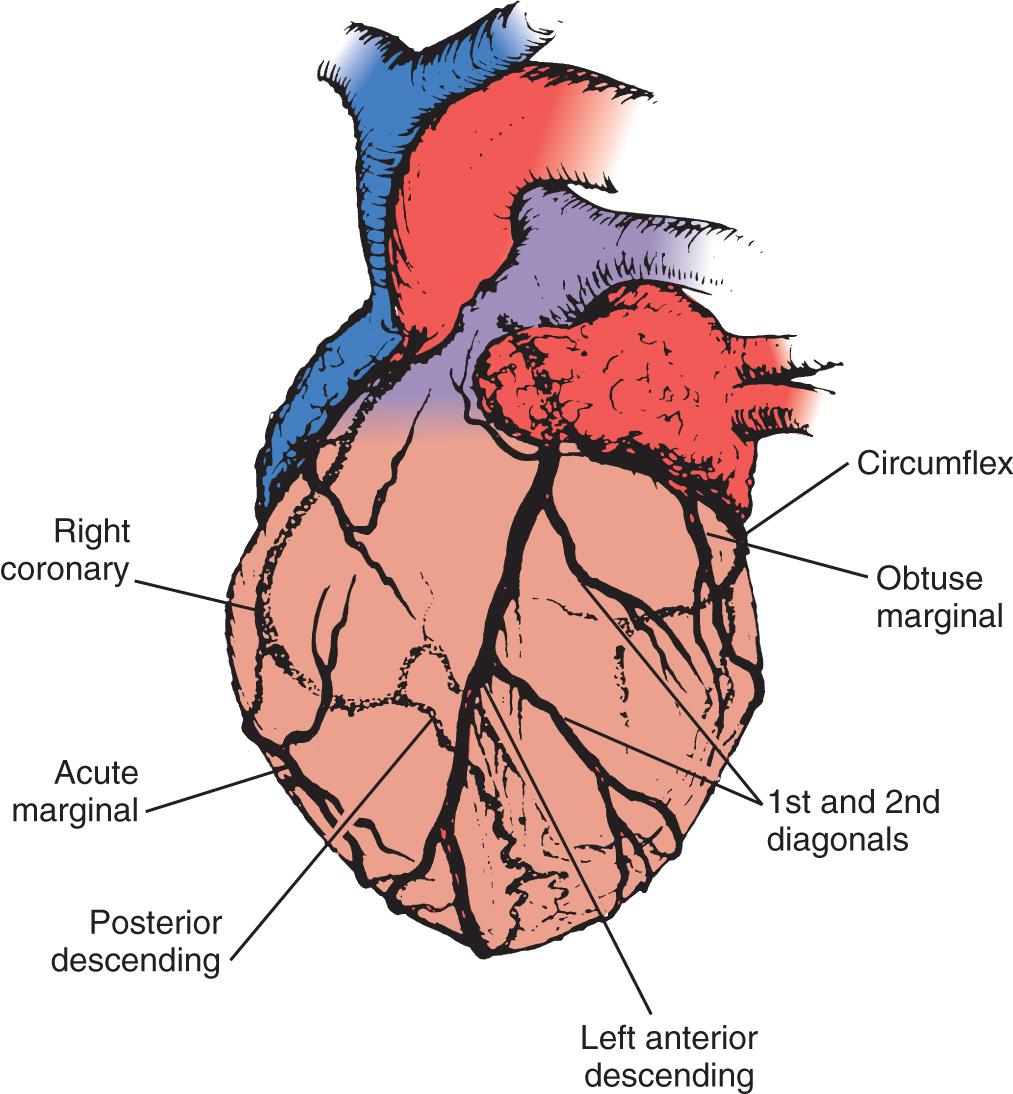
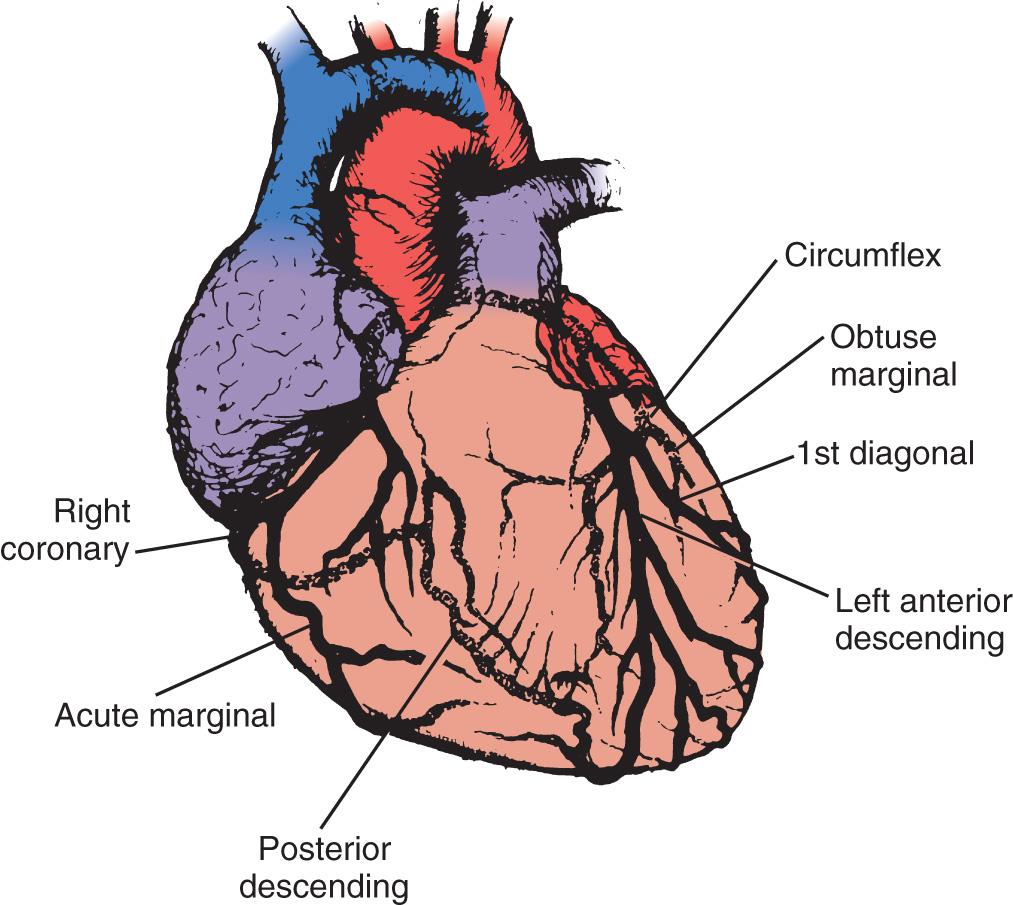
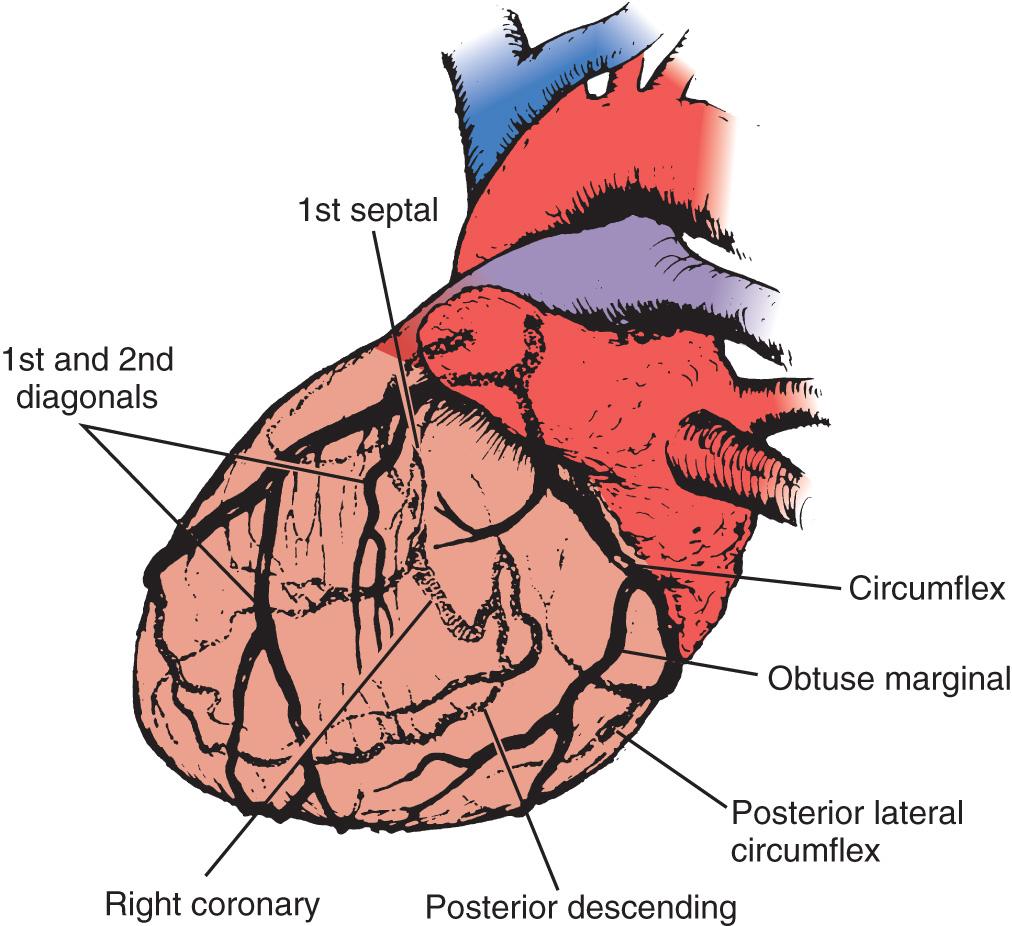
The right coronary artery (RCA) arises from the right sinus of Valsalva and is best seen in the left anterior oblique view on coronary cine angiography. It passes anteriorly for the first few millimeters and then follows the right atrioventricular (AV) groove and curves posteriorly within the groove to reach the crux of the heart, the area where the interventricular septum (IVS) meets the AV groove. In 84% of cases, it terminates as the posterior descending artery (PDA), which is its most important branch because it is the sole supply to the posterosuperior IVS. Other important branches are those to the sinus node in 60% of patients and the AV node in approximately 85% of patients. Anatomists consider the RCA to be dominant when it crosses the crux of the heart and continues in the AV groove regardless of the origin of the PDA. Angiographers, however, ascribe dominance to the artery—right coronary or left coronary (ie, circumflex)—that gives rise to the PDA.
The vertical and superior orientation of the RCA ostium allows easy passage of air bubbles during aortic cannulation, cardiopulmonary bypass (CPB), or open valve surgery. In sufficient volume, myocardial ischemia involving the inferior left ventricular (LV) wall segments and the right ventricle may occur ( Fig. 14.5 ). In contrast, the near-perpendicular orientation of the left main coronary ostium makes air embolization much less common.
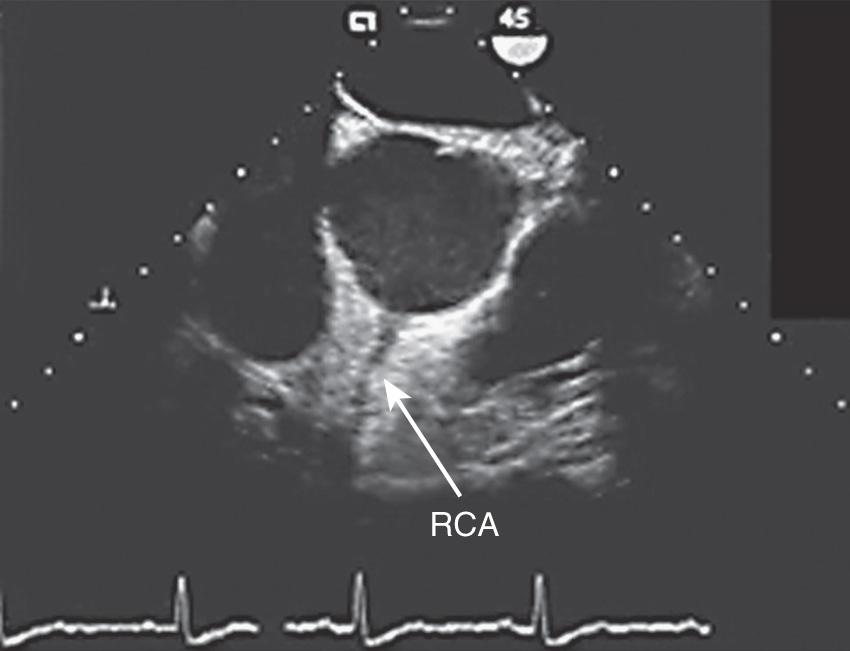
The left coronary artery arises from the left sinus of Valsalva as the left main coronary artery. It is best seen in a shallow right anterior oblique projection (see Fig. 14.3 ). The left main coronary artery courses anteriorly and to the left, where it divides in a space between the aorta and pulmonary artery. Its branches are the left anterior descending (LAD) artery and circumflex artery. The LAD passes along the anterior interventricular groove. It may reach only two-thirds of the distance to the apex or extend around the apex to the diaphragmatic portion of the left ventricle. Major branches of the LAD are the diagonal branches, which supply the free wall of the left ventricle; and septal branches, which course posteriorly to supply the major portion of the IVS. Although there may be many diagonal and septal branches, the first diagonal and first septal branches serve as important landmarks in the descriptions of lesions of the LAD.
The circumflex artery arises at a sharp angle from the left main coronary artery and courses toward the crux of the heart in the AV groove. When the circumflex artery gives rise to the PDA, the circulation is left dominant, and the left coronary circulation supplies the entire IVS and the AV node. In approximately 40% of patients, the circumflex artery supplies the branch to the sinoatrial node. Up to four obtuse marginal (OM) arteries arise from the circumflex artery and supply the lateral wall of the left ventricle.
All of the previously described epicardial branches give rise to small vessels that supply the outer third of the myocardium and penetrating vessels that anastomose with the subendocardial plexus. The capillary plexus is unique in that it functions as an end-arterial system. Each epicardial arteriole supplies a capillary plexus that forms an end loop rather than anastomosing with an adjacent capillary from another epicardial artery. Significant collateral circulation does not exist at the microcirculatory level. The capillary anatomy explains the distinct areas of myocardial ischemia or infarction that can be related to disease in a discrete epicardial artery. CAD most commonly affects the epicardial muscular arteries with rare intramyocardial lesions (with the exception of the transplanted heart). However, severe disorders of the microcirculation and primary impairment of coronary vascular reserve in normal coronary arteries have been described, especially in patients with diabetes, females, and those with variant angina. Epicardial lesions can be single but are more often multiple. A combined lesion of the RCA and both branches of the left coronary artery is referred to as triple-vessel disease . Venous drainage of the myocardium primarily occurs through the coronary sinus, which enters the right atrium between the inferior vena cava and the tricuspid valve. A small fraction enters the cardiac chambers directly through the Thebesian veins.
In patients with CAD, myocardial ischemia usually results from increases in myocardial oxygen demand exceeding the capacity of the stenosed coronary arteries to increase oxygen supply ( Fig. 14.6 ). In atherosclerotic heart disease, the fundamental lesion is an intimal lipid plaque in the epicardial portion of a coronary artery that causes chronic stenosis and episodic thrombosis and sudden plaque rupture that results in almost complete occlusion. Characteristics of the vulnerable plaque include a high lipid content, a thin fibrous cap, a reduced number of smooth muscle cells, and increased macrophage activity. Chronic inflammation and acute processes such as a plaque rupture result in the release of vasoactive substances from platelets and leukocytes producing endothelial dysfunction and vasoconstriction and further reducing coronary blood flow (CBF). A larger plaque disruption and prolonged thrombosis produce a Q-wave infarction with transmural myocardial necrosis.
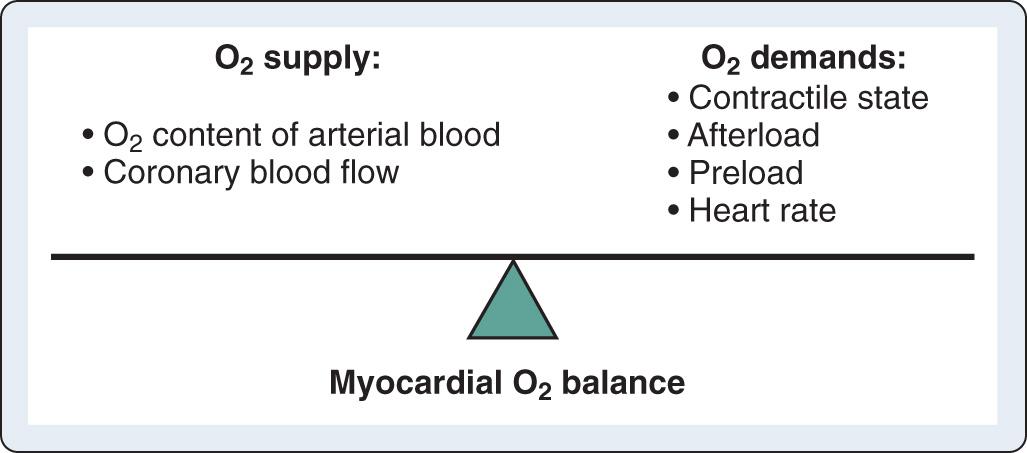
Collateral vessels exist in normal hearts, but in the setting of CAD, they are increased in size and number. Collaterals may develop between the ischemic zone and an adjacent nonischemic area supplied by a different vessel. Although beneficial at rest, during exercise or periods of increased oxygen demand, CBF may be shunted away from the ischemic myocardium to areas with intact autoregulation able to vasodilate; this is referred to as a coronary steal .
The practitioner providing anesthesia care for patients undergoing coronary revascularization has to implement an anesthetic plan that takes patient- and surgery-specific factors into consideration, but it should also include the most recent recommendations and guidelines regarding the perioperative care of patients with CAD.
In the earlier days of cardiac surgery, the focus on anesthesia management for patients undergoing CABG was mainly on maintaining hemodynamic stability and preventing ischemia. This reflected the lack of anesthetic agents with minimal hemodynamic effects. Later reports supported a lack of effect of the technique, suggesting that hemodynamic control was more important (ie, it is not what you use, but how you use it). With the introduction of modern anesthetic agents, the focus shifted to investigating how the various regimens and techniques could help to improve outcomes of patients undergoing myocardial revascularization. For example, considerable data demonstrate the beneficial effects of using potent inhalation agents or sympathetic blockade on markers of myocardial ischemia and postoperative MI, such as improved recovery and shorter length of stay (LOS).
The concept of premedication has been evolving beyond the traditional ordering of sedative-hypnotics or related agents to reduce patient anxiety and promote amnesia. The cardiac anesthesiologist must be familiar with the potential benefits of administering or hazards of not administering a variety of medications, including antianginal, β-blocker, and antiplatelet drugs.
The purposes of premedication are to pharmacologically reduce apprehension and fear, to provide analgesia for potentially painful events before induction (eg, vascular cannulation), and to produce some degree of amnesia. In patients with CAD, premedication may help prevent preoperative anginal episodes that are relatively commonly observed and may be elicited by tachycardia due to anxiety or painful stimuli. Short-acting benzodiazepines are the mainstay of drugs administered for this purpose. When given intravenously in the preoperative holding area to patients with CAD, supplemental oxygen should be administered and the patients monitored by pulse oximetry, an electrocardiogram (ECG), and noninvasive blood pressure (BP) methods.
Patients undergoing myocardial revascularization routinely take medications aiming to prevent acute coronary events, worsening of ischemia, or HF symptoms. Many of these drugs have implications for anesthesia management, and the anesthesiologist should be familiar with the current guidelines and recommendations outlining their use in the perioperative setting ( Box 14.1 ).
β-Adrenergic blockers
Should be administered for at least 24 hours before coronary artery bypass grafting (CABG) to all patients without contraindications (eg, hypotension, third-degree heart block, bronchospasm).
After CABG surgery, should be reinstituted as soon as possible in all patients without contraindications.
Statins: All patients undergoing CABG should receive them unless contraindications apply.
Calcium channel blockers: Patients already on calcium channel blockers should continue them perioperatively.
Angiotensin-converting enzyme inhibitor:
Preoperative discontinuation is controversial (ie, increased risk of hypotension and vasoplegic syndrome).
Postoperatively, should be initiated and continued indefinitely in CABG patients who are stable unless contraindications apply.
Diuretics: No firm recommendations, but ensure adequate serum potassium levels.
Aspirin: Should be administered preoperatively. The decision about whether and when to discontinue aspirin before surgery depends on patient-specific factors such as individual risk for bleeding and presence of an acute coronary syndrome. Postoperatively, aspirin should be started as early as possible (ie, within 6 to 24 hours after surgery).
Antiplatelet agents such as oral inhibitors of purinergic receptor P2Y12: Because they are associated with an increased risk of bleeding, recommendations call for withholding for a few days before surgery. However, in high-risk patients and/or after placement of drug-eluting stents, recommendations may change, and intravenous glycoprotein IIb/IIIa inhibitors or cangrelor may be continued perioperatively despite increased risk of bleeding.
Heparin: Regimen often depends on the surgeon. Usually discontinued 4 hours preoperatively for stable patients, continued up to and through pre–cardiopulmonary bypass period for critical left main disease or acutely unstable angina patients.
Oral hypoglycemic agents: No firm recommendations; consider withholding administration. However, glucose control must be ensured.
Antibiotic prophylaxis: Optimal timing and weight adjustment (especially important with antibiotics that have slow tissue penetration such as vancomycin). Typically, a second-generation cephalosporin such as cephazolin (2 g IV) or cefuroxime (1.5 g IV) administered 20 to 60 minutes before incision; vancomycin (15 mg/kg) administered as a slow infusion to avoid hypotension and flushing (owing to slow tissue penetration, infusion should be completed 20 to 30 minutes before skin incision).
β-Blocking agents are routinely administered to many patients with CAD. As early as the mid-1970s, Kaplan suggested that it was safe to continue β-blockade in patients with ischemic heart disease undergoing cardiac or noncardiac surgery, even those with poor ventricular function. This was confirmed in many prospective, randomized trials that established the safety of continuing β-blockade in the perioperative period.
In a metaanalysis, Wiesbauer et al. found that perioperative β-blockers reduced perioperative arrhythmias after cardiac surgery, but they were unable to show an effect on MI or mortality. Based on the existing evidence from a few randomized, controlled trials, retrospective studies, and metaanalyses, β-blocker use was recommended by many specialty societies for patients undergoing CABG.
The 2011 American College of Cardiology Foundation and American Heart Association (ACCF/AHA) guideline for CABG surgery recommended that β-blockers should be administered for at least 24 hours before CABG to all patients without contraindications to reduce the incidence or clinical sequelae of postoperative atrial fibrillation (AF). The guidelines state that β-blockers in patients with CABG with an ejection fraction (EF) greater than 30% can be effective in reducing the risk of in-hospital mortality and the incidence of perioperative myocardial ischemia. In patients with severely depressed LV function (EF <30%), the effectiveness of preoperative β-blockers in reducing the in-hospital mortality rate is uncertain. After CABG, β-blockers should be reinstituted as soon as possible for all patients without contraindications.
In 2015, the AHA published a scientific statement complementing the existing guidelines that focused on secondary prevention measures after CABG. The expert statement supports the recommendation to give β-blockers starting before surgery, including administering them to patients with prior MI unless contraindicated (eg, bradycardia, severe reactive airway disease). In patients with previous MI, β-blockers are specifically recommended for patients with HF symptoms and an EF below 40%.
In accordance with current guidelines, most patients undergoing CABG are treated with platelet inhibitors. Aspirin is a well-recognized component of primary and secondary prevention strategies for all patients with ischemic heart disease. Clopidogrel administration is established practice after coronary artery stent placement, and it is recommended in combination with aspirin for patients with ACS.
Guidelines summarizing the current evidence regarding antiplatelet drugs in patients undergoing surgery have been published by various specialty societies and are updated regularly. The most recent update of The Society of Thoracic Surgeons guidelines on the use of antiplatelet drugs in patients undergoing CABG was published in 2012. The highest level of evidence (class I recommendation, level A evidence) was found for aspirin administration within 6 to 24 hours after surgery in nonbleeding patients to optimize vein graft patency, and for dual antiplatelet therapy for patients undergoing CABG after ACS as soon as the bleeding risk is diminished to decrease adverse cardiovascular outcomes. The class I recommendation with level B evidence advised discontinuing inhibitors of the receptor P2Y12 for a few days before surgery to reduce the risk of bleeding and need for blood transfusion.
The 2011 ACCF/AHA guideline for CABG surgery recommended that aspirin should be administered to CABG patients preoperatively. For elective CABG, clopidogrel and ticagrelor should be discontinued for at least 5 days before surgery and prasugrel for at least 7 days to limit the need for blood transfusions. For urgent surgery, clopidogrel and ticagrelor should be discontinued for at least 24 hours to reduce major bleeding complications. Postoperatively, aspirin should be started within 6 hours after surgery. For those allergic to aspirin, clopidogrel should be used instead. Low-dose aspirin should be continued indefinitely. The 2015 AHA scientific statement on secondary prevention measures after CABG confirmed these recommendations and recommended dual antiplatelet therapy with aspirin and clopidogrel for 1 year.
Potent antiinflammatory and antithrombotic effects and beneficial effects on endothelial function and angiogenesis have been reported for 3-hydroxy-3-methyl-glutaryl–coenzyme A (HMG CoA) reductase inhibitors (ie, statins). Improved outcomes also have been described for patients undergoing CABG. This includes attenuation of myocardial reperfusion injury after CPB, reducing short- and long-term mortality rates, and decreasing early graft occlusion in patients with CABG.
Based on the accumulating evidence for the beneficial effects of statin therapy in patients undergoing myocardial revascularization, guidelines have been adjusted. The 2011 ACCF/AHA guideline for CABG surgery recommended that, unless contraindications apply, all patients undergoing CABG should receive statin therapy with the goal of lowering low-density lipoprotein (LDL) cholesterol by at least 30% or to less than 100 mg/dL. Even lower targets may be advisable (<70 mg/dL) for very high-risk patients. The most recent AHA scientific statement on secondary prevention measures after CABG confirmed these recommendations, and recommended statin therapy starting preoperatively and continued after surgery.
Become a Clinical Tree membership for Full access and enjoy Unlimited articles
If you are a member. Log in here